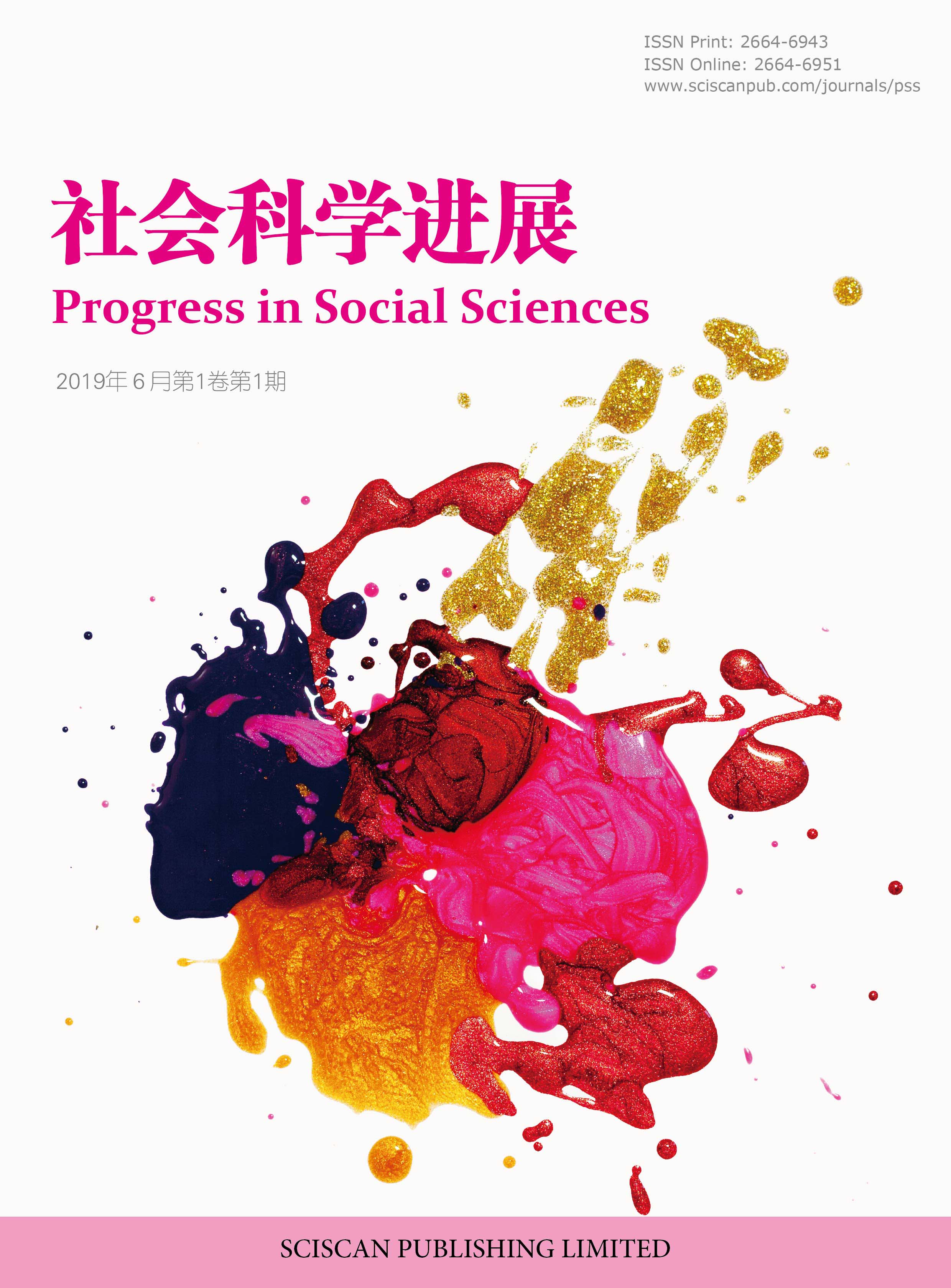Progress in Social Sciences
传播学“5W”模式下的新时代中国对外话语传播
International Communication of New Era Chinese Political Discourse Under the Framework of the “5W” Model
- Authors: 周续 姜正渝
-
Information:
中国矿业大学(北京)文法学院,北京
-
Keywords:
5W model; International communication; Political discourse; New era5W模式; 国际传播; 话语体系; 新时代
- Abstract: This paper explores the evolution and strategies of international communication of China’s political discourse since 2012, within the context of a new era. It begins by reviewing the current state of research in the field, laying a theoretical foundation for subsequent analysis. The paper then delves into the distinct characteristics of China’s political discourse in the new era, highlighting its uniqueness and influence in the process of globalization. At its core, the study examines the practical application of the “5W” model in the international dissemination of China’s political discourse in the new era—comprising Who (communicator), What (content), Why (motivation), Whom (target audience), and How (method). This highlights the significance of the model in enhancing communication efficiency and effectiveness. Through an in-depth analysis of various case studies, the flexible application and practical relevance of the “5W” model in real-world scenarios are demonstrated. The paper summarizes the achievements and challenges of international communication of China’s political discourse in the new era. It underscores how, under the guidance of the “5W” model, more precise targeting of communication objectives, optimization of content, enhancement of international image, and addressing the complexities of the global public opinion environment can be achieved. 本文聚焦于2012年中国进入新时代以来中国对外话语传播体系的演变发展,首先对相关领域的研究现状进行梳理,为后续分析提供理论基础,接着深入剖析了新时代中国国际传播话语的特质,彰显其在全球化进程中的独特性与影响力。文章核心部分着重探讨了“5W”模式在新时代中国国际传播话语中的实践应用,即传播者(Who)、信息内容(SayWhat)、媒介(WhichChannel)、传播受众(ToWhom)、传播效果(WithWhatEffect)的“5W”模式,即拉斯韦尔模式。五个关键要素,揭示了该模式在提升国际传播效率与效果上的重要性。通过对典型案例分析,本文展现了“5W”模式在实际应用中的灵活运用和现实意义,并总结了新时代中国国际传播话语体系的成就与挑战,强调了在“5W”模式指导下,如何更精准地定位传播目标,优化传播内容,提升国际形象,以及应对全球舆论环境的复杂性。
- DOI: https://doi.org/10.35534/pss.0605136
- Cite: 周续,姜正渝.传播学“5W”模式下的新时代中国对外话语传播[J].社会科学进展,2024,6(5):1285-1292.
1 引言
在全球化大背景下,中国正面临着如何在国际社会中塑造一个全面、真实、立体的国家形象,以及在全球治理中争夺更多话语权的严峻挑战。自2012年中国进入新时代以来,中央和地方政府,以及社会各界力量日益重视对外传播工作,力图在国际舆论环境中发出中国声音、传播中国文化、讲好中国故事,并推广中国经验,以期提升国家软实力,发出更多中国声音。然而,中国国际传播工作却常常面临着英美发达国家主导的国际叙事旧框架带来的挑战,由此产生信息传播不对等和误解等现象。
西方媒体和学术界在它们塑造“中国形象”时,往往带着预设的偏见,采用非平衡的视角,以至于中国对外话语在国际传播中面临困境。例如,西方社会常将中国描绘为“威胁”“对手”,而非全球治理的建设者和参与者。为了打破这种单向度的叙事,中国国际传播工作者借鉴传播学的经典理论,即传播者(Who)、信息内容(Say What)、媒介(Which Channel)、传播受众(To Whom)、传播效果(With What Effect)为核心的“5W”模式,以实现更有效、多元的国际传播。这一模式能够系统性地审视并优化对外话语的国际传播,确保信息准确传递,减少文化折扣,增进海外受众对中国政治理念和实践的了解与接受。
新时代下的中国国际传播话语不仅涉及政策宣介和外交活动,还包括通过媒体、教育、文化、经济等多渠道多层次的交流。在“5W”模式的指导下,中国政府和相关机构不断探索和实践,从高层外交活动的亲和表达,到新媒体平台的创新运用,再到提供国际公共产品,都力求提升对外话语在国际舞台上的可见度和影响力。通过案例分析,我们可以看到“5W”模式在实际应用中的价值,它帮助中国对外话语找到合适的传播者,设计具有吸引力的内容,明确传播目标,选择有效的传播渠道,以及制定策略以应对复杂的国际舆论环境。
尽管“5W”模式为新时代中国国际话语传播提供了有力的理论支持和操作框架,但挑战依然存在。如何在信息过载的互联网时代,精准定位目标受众?如何有效回应西方的刻板印象?如何构建复调传播体系以平衡国际舆论?这些都是中国在国际传播中需要进一步探讨和实践的问题。因此,本研究旨在通过深入剖析“5W”模式在具体案例中的应用,为优化中国对外话语的国际传播策略提供实证依据,为提升国家软实力和国际形象提出建设性建议。
2 “5W”模式理论基础以及对中国国际话语传播的应用可行性分析
“5W”传播模式,即从传播主体、传播内容、传播渠道、传播受众、传播效果五个方面进行传播行为中的控制研究、内容分析、媒介研究、受众研究和效果研究。“5W”模式源于早期新闻学研究,由美国哈罗德·D·拉斯韦尔首次提出,用以描述新闻报道的要素,后来被广泛应用于传播学领域,成为分析信息传播过程的重要框架。该模式包括五个关键问题:who(谁)是信息的来源、say what(什么)是传播的内容、to whom(向谁)传播、which channel(如何)进行传播,以及with what effect(效果)如何。这五个元素彼此关联,共同构建了一个系统的传播过程,它们不仅适用于新闻报道,同样适用于更广泛的信息传播,如对外话语国际传播。
在新时代中国对外话语国际传播中,“5W”模式提供了理论依据和实用工具,帮助决策者和传播者从不同角度审视和优化传播策略。
首先,who(传播者)涉及传播的主体识别,中国政府、官员、外交人员、学者、媒体等多元主体的互动和协作,共同构建了一个国际化的传播网络。在国际舞台上,传播者的信誉和权威性对信息的接受程度有着显著影响。其次,say what(传播内容)则是对所传达信息的实质分析。新时代中国国际话语传播的内容通常包括中国的国家政策、发展成就、文化价值以及全球治理的主张。这些内容往往以更加开放、包容和自信的态度展现,以期在全球舆论中引起共鸣,提升中国的话语权。再次,which channel(传播手段)则关注传播的媒介和策略。在新时代,中国对外话语国际传播的手段日益多元化,包括传统媒体如电视、报纸和广播,新型媒体如社交媒体、网络平台,以及国际会议、公共外交活动等。
此外,to whom(目标受众)的明确,决定着传播的针对性和适应性。新时代中国对外话语国际传播的目标受众不仅包括各国政府和政策制定者,还包括知识精英、媒体从业者、普通公众等不同层级和类型的受众,传播者需根据不同受众的文化背景、价值观和信息需求,调整传播的内容和方式。最后,with what effect(效果)则是最终的追求。中国国际话语传播往往以提升国家形象、传播中国经验、引导国际议题,以及反驳和纠正不实的西方叙事为主要目标。理解这些目标有助于制定更有效的传播策略,确保传播的连贯性和一致性。
由此,我们可以清楚地看到,通过深入理解并应用“5W”模式,新时代中国对外话语国际传播能够更精准地定位传播目标,设计符合受众需求的内容,选择合适的传播渠道,明确传播动机,以及制定灵活多样的传播手段。这不仅有助于提升中国对外话语的国际影响力,也有助于在全球范围内塑造一个全面、真实的中国形象。
3 中国对外话语国际传播的研究现状
自20世纪90年代以来,中国对外话语及其国际传播的研究逐渐成为学术界关注的焦点。早期研究主要关注中国对外传播的策略与实践,如官方媒体的对外宣传、国际新闻报道、公共外交活动等。随着中国在全球事务中的影响力日益提升,研究逐渐转向中国对外话语的内涵及其国际传播效果,如中国道路、中国模式的国际接受度。
在对外话语体系的构建原则和路径方面,学者们提出了多个重要观点。孙新提出了构建中国特色对外话语体系的五个原则:坚守国家立场、明确道义定位、善于事实说话、努力融通中外、体现兼容并包。他还指出了四个具体的构建路径:构建中国政治话语内容、深化政治话语翻译工作、优化政治话语传播格局、加强政治话语队伍建设。郭晓科等人则从话语体系的结构角度进行了分析,认为话语体系具有多层结构,由内而外依次为价值观念、政治理念、表达方式和呈现形式。他们强调,系统建构中国自主知识体系是中国对外话语体系的基础,同时要注重政治话语和学术话语向大众话语转化和国际化表达。
在国际传播策略方面,学者们探讨了如何运用新媒体技术,如社交媒体、网络平台,来扩大中国声音的国际覆盖。余江和李文健从实践角度指出了中国国际传播领域存在的主要问题,如民间传播与隐性传播不充分、内容思维与技巧运用不完善、以我为主与借题发声不匹配、答题与设问不对等、应对议程与设置议程不均衡等。针对这些问题,他们提出了加强国际传播能力系统化建设的路径创新,包括内容优化与技术引领、渠道拓展和品牌创新、对内传播与对外传播统筹共振、人才培养与学科建设提升完善、国际传播理论创新等。此外,也有研究指出,通过构建多层次、多渠道的国际传播网络,如结合政府、学术界、企业、非政府组织的多重力量,可以提高中国对外话语的国际影响力。
然而,中国对外话语国际传播的研究仍存在一些局限。首先,尽管研究者已经开始关注“5W”模式在其中的应用,但实证分析和案例研究相对较少,缺乏对这一模式在具体传播情境中效果的深入探讨。其次,研究往往侧重于宏观层面的策略分析,而在微观层面上,如目标受众的心理接受机制、个性化传播策略等方面,研究尚显不足。虽然近年来学者们开始关注“新构建主义”理论在国际传播中的应用,尝试将这种强调学习者主动构建知识的理论与对外话语传播相结合,以提升信息的吸引力和接受度。然而,这一领域的研究仍处于初步阶段,需要更多实证研究来验证其有效性。
中国对外话语国际传播的研究已取得一定进展,但仍有待进一步挖掘和拓展。未来的研究可从以下几个方面进行:深入分析“5W”模式的实践应用,通过案例研究揭示其在具体情境中的效果;探讨新媒体环境下如何更有效地针对不同目标受众进行个性化传播;结合“新构建主义”理论,探索如何在传播中鼓励受众主动参与,以提升信息的传播力。这样,才能更全面地理解新时代中国对外话语国际传播的现状与挑战,为优化传播策略提供更为丰富的理论依据和实践参考。
4 新时代中国对外话语的特点
新时代中国对外话语的特点是在全球化的语境中,既继承了中国传统文化的精髓,又融合了现代价值观,展现出一种开放、自信、包容和创新的面貌。在传播内容上,它强调中国特色社会主义理论体系的丰富内涵,如习近平新时代中国特色社会主义思想,以及中国在全球治理中的主张,如构建人类命运共同体。这一时期的对外话语不仅关注经济发展和科技进步,还深入探讨文化软实力、可持续发展和国际安全等议题,体现了中国作为一个负责任大国的全球视角和战略思维。
在传播者方面,新时代中国对外话语的传播主体呈现出多元化的特征,包括国家领导人、政府机构、外交使团、学者、媒体,以及民间组织等。这些主体在国内外通过各种渠道共同发声,形成了一种矩阵式的传播网络,确保了信息的多维度、多角度表达,提高了信息的可信度和影响力。
在目标受众的定位上,新时代中国对外话语既注重与主要大国的对话与互动,也关注与新兴市场和发展中国家的沟通,以及对全球知识精英和公众的传播。传播者需要根据不同受众的文化背景、信息获取渠道和价值观,调整传播内容的表达方式,以增强信息的吸引力和接受度。
传播手段的创新是新时代中国对外话语国际传播的一个显著特点。新媒体技术的运用,如社交媒体、短视频平台、在线直播等,使得信息传播更加快捷、直观,能够触及更广泛的受众。此外,借助国际会议、公共外交活动,以及各种文化交流项目,中国对外话语在多元化的平台上得以展现。
在传播效果上,新时代中国对外话语国际传播旨在提升国家的国际形象,展示中国道路、理论、制度和文化的优势,反驳和纠正西方的刻板印象,引导国际舆论,促进各国对中国的全面、深入理解,以及推动全球议题的建设性参与。这背后的战略考量是保障中国在全球治理中的正当权益,推动国际社会公正合理的国际秩序构建。
时空环境的选择与适应也是新时代中国对外话语国际传播的特点。随着全球媒体环境的变迁,中国对外话语传播工作者学会了把握“窗口期”,在关键时刻通过精心策划的活动和内容,及时有效地传递信息,应对国际舆论的热点和变化。
新时代中国对外话语的特点体现在内容的丰富性、传播主体的多元性、动机的战略性、目标受众的针对性、手段的创新性,以及时空选择的灵活性。这一系列特点的形成,是基于对全球政治经济环境的深刻洞察,以及对传播学“5W”模式的灵活运用,旨在构建一个与时代同步、与世界对话的中国声音,提升国家软实力,促进人类文明的交流互鉴。通过深入探讨这些特点,我们能更好地理解中国对外话语国际传播的策略和效果,为优化传播实践提供理论指导。
5 5W模式在新时代中国对外话语国际传播中的应用
5.1 传播者(Who)
在新时代中国对外话语国际传播中,传播者(Who)的角色至关重要,是信息的源头,负责将内容有效传递给目标受众。新时代的传播者群体呈现出多元化和立体化的特征,不仅包括传统的政府和官方机构,如外交部、国务院新闻办公室,还包括非政府组织(NGOs)、学术界、企业、媒体,以及民间力量,甚至个体公民也可以通过社交媒体成为信息的扩散者。这种多元主体的传播网络有助于增强信息的可信度和说服力,实现全方位、多层次的国际传播。
国家领导人,如习近平主席,在国际重要场合的演讲和声明,以其权威性和亲和力,成为塑造国家形象和传达政策主张的关键传播者。通过高层外交活动,他们向世界传递中国的声音,同时为其他传播主体提供政策指导和战略方向。中国政府机构,如外交部和新闻办公室,负责制定和执行传播策略,通过新闻发布、媒体沟通、国际会议等形式,向全球传达中国政府的政策和主张。此外,他们还负责协调其他传播主体的活动,确保信息的统一和连贯。
非政府组织,如孔子学院、中国改革与发展研究会等,通过文化交流、学术交流等活动,以更加民间和学术的方式来传播中国的声音,增加信息的亲和力和接受度。学术界,包括研究机构和高校,通过发表论文、参加国际学术会议、开展国际合作研究等方式,传播中国在各领域的研究成果和理论观点,提升中国在国际学术领域的影响力。
企业,特别是具有全球影响力的跨国企业,如小米、华为、阿里巴巴等,通过其商业活动和企业文化,展示中国企业的实力和创新,为国家形象增色。媒体,包括传统媒体如新华社、中央电视台,以及新媒体如CGTN、微博、微信等,是信息传播的主要渠道。它们通过报道、评论、互动等形式,将对外话语转化为易于理解的内容,传递给全球受众。
在运用“5W”模式分析传播者时,关键在于明确不同主体的定位和职责,以及如何通过有效的合作和互动,构建一个协同一致的传播网络。这包括强化传播主体的责任意识,提供专业培训,提升其国际传播能力,以及通过技术手段如大数据和人工智能,实现信息的精准推送。通过这种多元化的传播者网络,新时代中国对外话语能够更广泛、深入地触及不同类型的受众,提高国际传播的效率与效果。同时,通过不断发展和适应国际传播环境的变化,确保中国对外话语在国际舞台上始终保持活力和影响力。
5.2 信息内容与媒介(Say What and Which Channel)
在全球化的语境中,新时代中国对外话语的国际传播注重内容的创新和媒介的多元化。在 say what(说什么)的环节,中国对外话语从理论到实践,都展现出开放、包容和自信的特质,不仅涵盖国家政策、发展成就、文化价值,还包括全球治理的主张和实践经验。习近平新时代中国特色社会主义思想是这一时期对外话语的核心,它以人类命运共同体为愿景,倡导共商共建共享的全球治理理念,体现了中国对世界和平与发展的积极贡献。为了减少文化隔阂,提升国际认同,中国对外话语在对外传播时,强调叙事的亲和力和故事性,力求将宏大理论与具体案例相结合,使全球受众能够更容易理解和接受。
在 say which channel(选择哪种媒介)方面,新时代中国对外话语的国际传播已从传统的电视、报纸、广播等媒介,拓展到网络、社交媒体、短视频平台等新媒体。这些新媒介的运用,如利用Meta、X、YouTube等社交平台,以及微信、抖音等本土化应用,能够触及全球更广泛、更具活力的受众群体。中国政府还借助国际会议、公共外交活动,如博鳌亚洲论坛、G20峰会等,以及中国文化周、孔子学院等文化交流项目,来传播对外话语,扩大其全球覆盖面。同时,借助数字化技术,如直播、虚拟现实等,使得信息的传达更加生动、直观,增强与受众的互动性。
在选择媒介时,传播者会考虑目标受众的媒体使用习惯,以确保信息的准确传达。例如,对于年轻受众,可能会更多地利用TikTok或Instagram等视觉驱动的社交媒体;对于政策制定者和学者,可能会通过专业论坛、学术期刊、报告发布等方式传播。此外,针对不同地区和文化背景的受众,传播者会通过本地化的语言和内容,确保信息的适应性和吸引力。
“5W”模式中的 say what 和 say which channel 的环节,要求传播者深入理解目标受众的需求和偏好,以及不同媒介的特性。在 say what 中,这意味着要创造具有吸引力和说服力的内容,同时考虑文化差异,确保信息的可接受性和共鸣。而在 say which channel 中,则需精心选择媒介,以确保信息能够有效到达受众,并产生积极的传播效果。通过动态调整内容与媒介策略,新时代中国对外话语国际传播能够在不断变化的媒体环境中保持其有效性和影响力,进一步推动中国在全球议题中的能见度和参与度。
5.3 传播受众与效果(To Whom and With What Effect)
在新时代中国对外话语国际传播中,对目标受众的理解和传播效果的评估是“5W”模式的关键部分。who(传播者)、what(传播内容)、why(传播动机)和how(传播手段)的策略制定,都是为了实现对whom(目标受众)的有效触达,以及产生特定的with what effect(效果)。
目标受众的精准定位是传播策略的核心。新时代的中国对外话语不仅要面向全球各国政府和政策制定者,更要关注普通公众、知识精英、媒体从业者,以及不同文化背景的群体。传播者需深入研究不同受众的信息获取习惯、价值观、文化认知,以便调整内容的表述方式,让信息更具吸引力和亲和力。例如,对于西方受众,可能需要更注重逻辑性与证据支持;对于发展中国家的受众,则可能需要强调共情和互利合作。
传播效果的评估是衡量传播策略成功与否的重要标准。这包括信息的传播范围、受众的接受程度、态度变化,以及行为影响。传播者可以通过大数据分析、问卷调查、社交媒体监测等方式,量化评估目标受众的反馈。例如,通过监测对外政策演讲的国际媒体报道数量和观点倾向,了解各国对中国的认知变化;通过社交媒体的互动数据,掌握公众对特定议题的讨论热度。此外,传播效果的评估还应关注长期影响,如中国在全球议题中的影响力提升,以及国际社会对中国国家形象的接纳程度。
传播效果的评估为策略调整提供了依据。如果发现某些传播手段未能达到预期目标,或效果不佳,传播者应重新审视who、say what、to whom以及which channel策略,找出潜在问题,并进行优化。例如,如果发现针对年轻受众的传播效果不佳,可能需要调整内容形式,采用更具互动性和趣味性的视频、游戏等媒介;如果发现西方媒体的报道偏负面,可能需要更积极地利用国际公关手段,提升正面信息的曝光度。
中国对外话语国际传播应注重多元视角和动态调整,以适应不断变化的国际舆论环境。通过与“新构建主义”理论的结合,鼓励受众参与到信息的接收和传播中,利用他们的经验和知识,提升信息的接受度和传播效力。同时,借助人工智能和大数据技术,构建更精准的受众画像,并根据反馈实时调整传播策略,实现传播效果的最大化。
在新时代中国对外话语国际传播中,对目标受众的精准把握和传播效果的有效评估是“5W”模式不可或缺的组成部分。通过深入研究目标受众的需求,制定针对性的传播策略,以及科学地评估传播效果,中国对外话语能够在复杂的国际环境中实现有效传达,提升国际影响力,推动全球多元文化的交流与理解。
6 中国对外话语国际传播案例分析
6.1 习近平总书记重要讲话及著作国际传播
习近平总书记的重要讲话和著作是中国对外话语的核心内容,它们在全球传播中扮演了至关重要的角色。这些演讲和著作涵盖了中国的发展战略、治国理念、国际政策、文化交流等多个方面,体现了新时代中国特色社会主义的理论与实践。通过国际传播,习近平的思想和主张被广泛传播,不仅推动了中国在全球治理中的角色,也加深了国际社会对中国的理解和认同。
习近平总书记的国际演讲,如在联合国大会、二十国集团峰会、博鳌亚洲论坛等重要国际场合的发言,成了展示中国主张的重要窗口。这些演讲通常以开放、包容的语气,阐述中国在全球问题上的立场,如气候变化、国际贸易、全球安全等,为构建人类命运共同体提供了中国方案。通过这些场合,习近平总书记阐述的“中国梦”“一带一路”倡议等具有全球影响力的议题,成功吸引了全球目光,提升了中国的话语权。
习近平的著作,如《习近平谈治国理政》系列,以其深度、广度和权威性,成为了解中国政治、经济、社会和文化的重要途径。这些著作被翻译成多种语言在全球发行,为国际读者提供了第一手了解中国政策和理念的材料。通过深入浅出的论述,习近平的著作在国际上普及了中国特色社会主义理论,展现了中国发展模式的吸引力。
在传播习近平总书记重要讲话和著作的过程中,中国政府和相关机构精心策划,利用多元化的传播手段。他们不仅通过官方渠道,如中国驻外使领馆、国家媒体,发布演讲实录和著作的翻译版本,还通过社交媒体、国际会议、学术研讨会等平台进行推广。同时,通过与国际知名出版社合作,确保著作的高质量翻译和广泛分发。
who(传播者)方面,习近平总书记作为国家主席,是具有极高权威的传播主体,其国际影响力为传播提供了强大支撑。say what(传播内容)则是习近平总书记的讲话和著作,它们是中国对外话语的重要组成部分,承载着中国发展的理念与实践。to whom(目标受众)不仅包括各国政府和政策制定者,还包括国际组织、学者、媒体从业人员,以及普通公众。which channel(传播手段)则包括多语种出版、在线发布、国际会议、媒体访谈等形式,确保信息的广泛传播和深度解读。with what effect(传播效果)在于提升中国在全球治理中的地位,推广中国智慧和方案,以及塑造正面的国家形象。
然而,国际传播的挑战依然存在,如西方主导的叙事框架可能带来的误解,以及不同文化背景下的信息接受度差异。因此,中国需要继续优化传播策略,如在内容上注重故事性的讲述,以减少文化折扣;在渠道上,依托新媒体与传统媒体的融合,提升传播效率;在目标受众的定位上,更加注重不同群体的特性和需求,以增强信息的吸引力。
6.2 “人类命运共同体”理念国际传播
“人类命运共同体”是新时代中国对外话语中的核心理念,体现了中国在全球化时代对国际合作与共同未来的深刻理解与愿景。这一理念的国际传播旨在跨越文化、国家与制度的界限,凝聚全球共识,构建公正合理的国际秩序。
(1)who(传播者)。在“人类命运共同体”理念的国际传播中,中国政府扮演着主导角色,通过外交活动、国际会议和多边组织,如联合国等,积极倡导这一理念。习近平主席多次在国际舞台上阐述这一理念,赋予其权威性和领导力。同时,中国非政府组织、智库、企业和公众也在各自的领域内传播这一理念,形成多元立体的传播网络。
(2)say what(传播内容)。“人类命运共同体”理念包含着对全球共同挑战的深刻洞察,如气候变化、公共卫生、国际贸易等问题,并提出中国方案,如“一带一路”倡议,致力于推动各国共享发展成果。内容富有创新性和包容性,旨在推动全球治理的改革,实现各国的共同发展。
(3)to whom(目标受众)。目标受众广泛,既包括各国政府、国际组织,也包括全球知识精英、媒体、公众和不同文化背景的群体。传播者需根据不同受众的语境、价值观和信息获取习惯,调整传播内容和方式,以提高信息的认同度和接受度。
(4)which channel(传播手段)。传播手段多样化,包括官方外交、国际会议、媒体宣传、公共外交活动、国际教育合作等。新媒体平台如微博、微信、YouTube等也在发挥重要作用,通过短视频、图文故事等形式,以更直观、生动的方式传播这一理念。同时,中国利用各类国际平台,如G20峰会、APEC会议,以及通过国际组织的报告和政策建议,持续推广这一理念。
(5)with what effect(传播效果)。传播“人类命运共同体”理念主要源自中国对全球公共利益关切,旨在提升国际社会对中国在全球治理中作用的认知,以及推动构建公正、公平、合作、共赢的国际关系。此外,这一理念也是中国应对西方叙事挑战,塑造积极国家形象的重要工具。
“人类命运共同体”理念的国际传播在一定程度上成功提升了中国在国际社会的影响力,促进了国际合作,也拓宽了全球公众对中国的认知。然而,传播效果依然受到西方媒体的偏见和文化隔阂的影响,需要持续优化传播策略,例如,利用故事化叙事方式减少文化折扣,通过第三方传播者降低信息接收的阻力,以及结合“新构建主义”理论,鼓励受众参与构建对这一理念的多元解读。
“人类命运共同体”理念的国际传播通过“5W”模式的运用,展示了新时代中国对外话语的国际传播策略,这一模式的深入实践将有助于中国在全球治理中发挥更大作用,推动构建更加公正、和谐的全球秩序。未来的研究和实践应进一步探索如何在不同文化背景下更有效地传播这一理念,以提高其全球接受度,实现人类共同的福祉。
7 结语
新时代中国对外话语国际传播在“5W”模式的框架下展现出显著的进步与创新。通过深入剖析传播者(Who)、信息内容(Say What)、媒介(Which Channel)、传播受众(To Whom)、传播效果(With What Effect)的互动,我们发现中国对外话语的全球影响力日益增强,策略日益精细化。
在传播者层面,从国家领导人到各种非政府组织,多元主体的协同合作构建了强大的国际传播网络,提高了信息的可信度。内容上(Say What),强调中国道路、理论、制度的自信表达,以及全球治理方案的提出,提升了中国话语的吸引力。目标受众(To Whom)的精准定位,从政府到公众,兼顾了不同层次的需求。传播手段(Which Channel)的创新,如新媒体的运用和国际平台的利用,使信息传播更具时效性和覆盖性。
然而,挑战依然存在,如西方主导的叙事框架、文化隔阂和舆论环境的复杂性。中国需持续优化传播策略,如提升内容的亲和力,灵活运用多种媒介,以及深入理解不同受众的心理接受机制。
本文通过实证研究与理论探讨,为优化中国对外话语国际传播提供了策略建议,对提升国家软实力具有实践指导意义。未来的研究可深入探究“5W”模式在特定情境下的实际效果,以及如何结合新技术和理论发展,以实现更高效的国际传播。通过不断探索和创新,新时代中国对外话语将能够在全球舞台上发出更响亮、更具说服力的声音,塑造更加立体、全面的国家形象,为构建人类命运共同体贡献力量。
参考文献
- 赵雅文.软传播:新时代中国故事和中国声音的对外传播[J].未来传播,2023(5):25-32.
- Lasswell H.The Structure and Function of Communication in Society [M].北京:中国传媒大学出版社,2013.
- 孙新.新时代中国特色对外政治话语体系构建孙研究[J].科学社会主义,2023(1):131-138.
- 郭晓科,刘俊,王瑾.全球话语竞争下的中国对外话语体系建构新思维[J].对外传播,2023(5):27-31.
- 余江,李文健.新作为、新论断与新路径:新时代加强国际传播能力建设的再思考[J].求是学刊,2021,48(6):12-19.
- 杜晓萱.基于5W传播模式的新媒体时代辽宁特色省域文化译介与国际传播研究[J].英语广场(学术研究),2023(15):27-30.
- 陈美妍.新媒体视域下“青年大学习”的思政教育创新——基于传播学中拉斯韦尔“5W”模式分析[J].今传媒,2023(4):147-150.
- 程秀红.新时代高校思政课话语体系创新模式探析[J].濮阳职业技术学院学报,2024(3):30-33.
- 邵延娜.基于5W传播模式的中医药文化海外译介研究[J].辽宁中医药大学学报,2023(8):178-181.
- 刘毅阳.“5W模式”下国家形象宣传片的传播分析——以《人物篇》与《中国进入新时代》为例[J].声屏世界,2020(16):18-20.
- 李思扬.基于传播学理论5W模式探讨新冠疫情下中国援外物资标语的翻译策略[J].时代人物,2020(35):378-379.
- 王晗.新时代中国共产党国际传播能力建设的话语建构与叙事转向[J].聊城大学学报(社会科学版),2022(5):86-94.
- 薛可.守正创新:新时代中国对外传播再思考[J].对外传播,2023(6):58-62.
- 曹曦晴.发挥广电视听优势 打造国际传播共创模式——湖北广播电视台国际传播工作机制创新与实践[J].现代视听,2023(8):107-109.
















